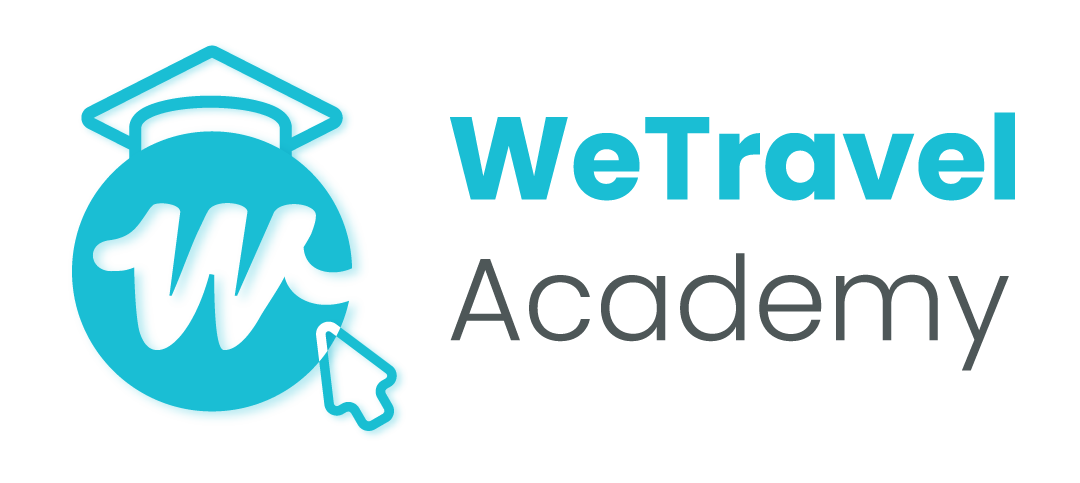How To Grow Organic Traffic To Your Travel Website With SEO
Getting website traffic through Search Engine Optimisation (SEO) is the best way to scale your travel business.
But nowadays it is very difficult to rank a website organically due to intense competition.
Have a look at the Google search results for the keyword phrase: “Holidays to Thailand”

There are over 40 million web pages in Google’s index relevant to this keyword phrase.
Trying to rank for this keyword would be really tough.
This explains why many small travel operators outsource their SEO efforts to digital consultants and agencies.
Outsourcing can work well, but if you are willing to invest some time and effort into learning the basics of SEO, you may find you have all the resources at your fingertips to skyrocket your organic traffic.
In this article we talk about SEO for small travel operators to show you exactly how you can get 10x results.
By the end of the article you will know:
1. How to do effective keyword research for your website content.
2. How Search Engine Optimization works and what you can do to rank your website.
3. How to use on-page and off-page search ranking signals to generate lots of organic traffic.
Reading Time: 19 Minutes
SEO 101
SEO is all about increasing the quantity and quality of organic traffic to a website.
Each day search engines, like Google and Bing, crawl the Internet using search robots to index webpages into their library. When a user then types into Google a search term, like “Family holidays in Morocco”, the search engine uses a complex algorithm that consists of 100s of ranking signals to determine the best quality and most relevant webpages to return.
These ranking signals broadly fall into two buckets:
- On-page SEO
- Off-page SEO
Below we discuss how you can master each, but before we get there we need to first understand the role keywords play in SEO.
Keyword Research
Search engine optimization starts with keyword research.
Without knowing what keywords your potential customers are typing into a search engine it is very difficult to know what to optimize for.
Keyword research involves figuring out the volume of searches for a particular keyword, the intent of the keyword phrase and its competition level.
For this you need to use a keyword research tool, like Google’s Keyword Planner (free with Google Adwords account), or free and paid software tools like Moz, Longtail Pro and SEMRush.
In this article we will demonstrate how to do keyword research using the paid SEO tool, Ahrefs.
Let’s start by looking at keyword volume.
Keyword Volume
The volume of a keyword refers to the number of unique searches per month.
The volume of a keyword can vary by the location of the search and the time of year, among other factors.
For example, the keyword “Yoga Retreats Bali” has higher search volume in Australia than in the US or UK, as more people from Australia visit Bali every year and go on retreat than people from the US and UK.
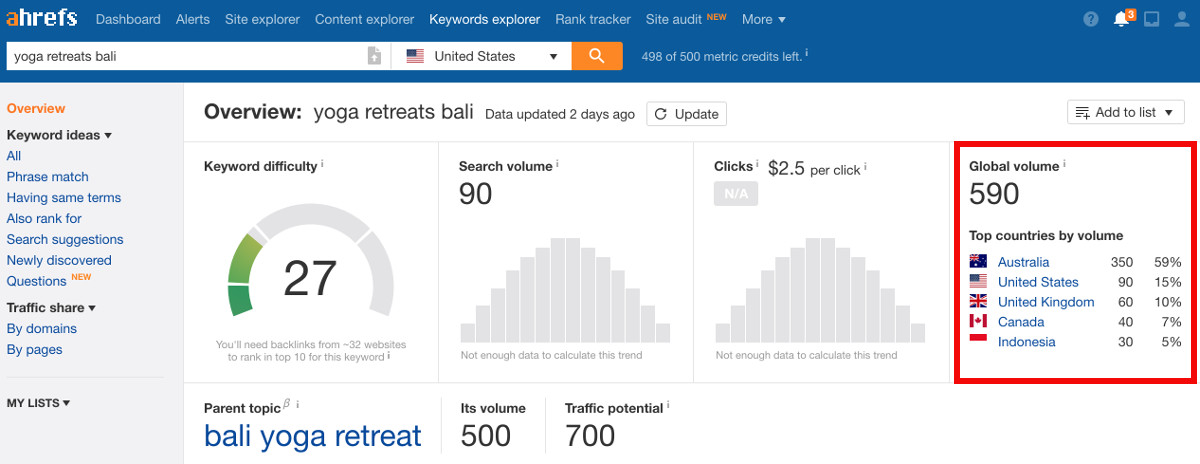
The same is true of a seasonal keyword like “Christmas Holiday Breaks”, which will peak in volume around October, November and early December when people are thinking of going on a Christmas holiday.
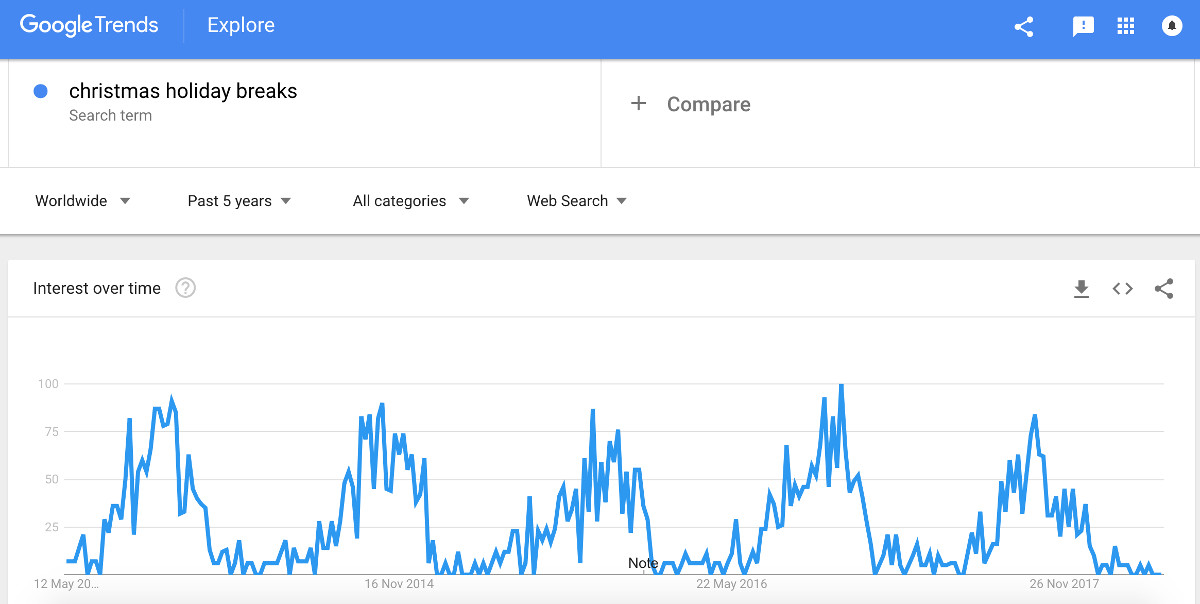
Generally speaking, keywords with lots of searches per month (high volume keywords) are better than keywords with only a handful of searches per month (low volume keywords), as the former can bring in a lot more traffic!
However, more volume doesn’t necessarily mean more inquiries and business. That is where our second consideration comes in.
Keyword Intent
The intent of a keyword is arguably more important than keyword volume as it distinguishes the intent behind a visitor’s search.
The higher the intent of a keyword, the better it is.
Knowing this, you can create content that serves that intent perfectly. For example, the keyword “Mexico” has lower intent than the keyword, “Holidays in Mexico”, as it is much easier to understand what someone is looking for in the latter.
There are three basic types of searches – navigational, informational and transactional.
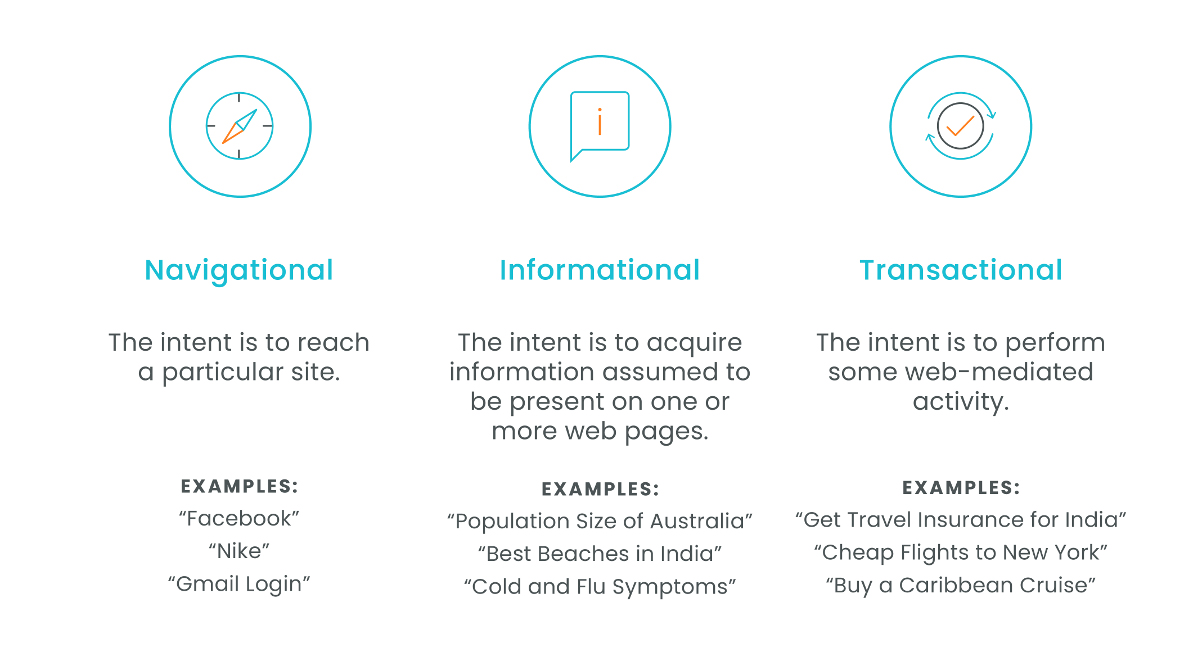
The intent of navigational keywords is to reach a certain site. For example, searches for brand names, like “Nike” or “Facebook” are navigational. Specific page searches, like “Gmail login” and "Apple customer service” would also be classified as navigational keywords.
Informational keywords are distinguished from navigational keywords, as the intent is to acquire information. For example, “Population Size of Australia”, “Best Beaches in India” or “Cold and Flu Symptoms” are informational keywords.
Transaction keywords express a desire to perform a web-based activity that is often transactional in nature. For example, “Get Travel Insurance for India”; “Cheap flights to New York” and “Buy a Caribbean Cruise” are transactional keywords.
Transactional keywords have high commercial intent and are therefore very valuable.
We will cover commercial keyword intent in more details in our Google PPC Advertising article, but for the purposes of this chapter, the higher the intent of a keyword – whether commercial or not – the better the keyword. This gives you more confidence about what a visitor is looking for.
Keyword intent tends to get clearer the longer the keyword, however, search volume decreases as the keyword lengthens.
Long tail keywords, as they are known in the industry, are great targets to start an SEO campaign with, as they tend to be less competitive.
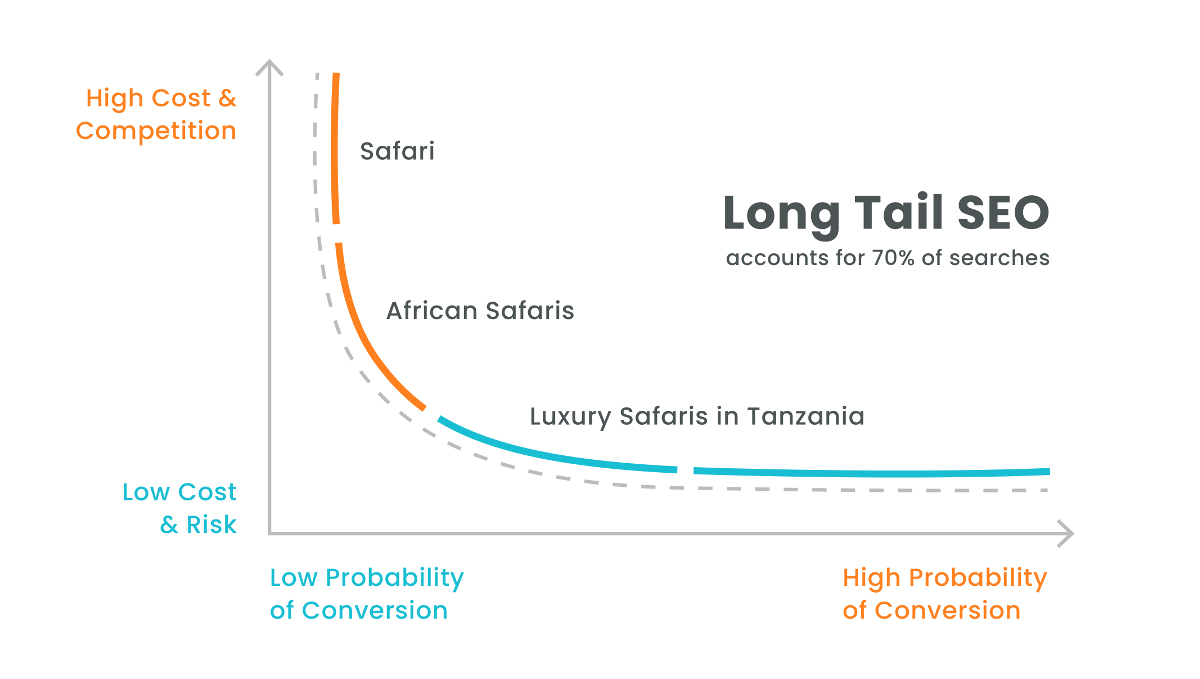
As illustrated above, keyword volume and intent impact the level of competition for a keyword.
Keyword Competition
Keyword competition refers to the intensity of competing websites and pages trying to rank for a keyword.
Generally speaking, the higher the keyword volume and the clearer the commercial intent, the higher the competition.
High Keyword Volume + High Commercial Intent = High Levels of Competition
For example, the keyword phrase “Cheap Flights” has lots of competition, because it has very good keyword volume and the phrase has high commercial intent.
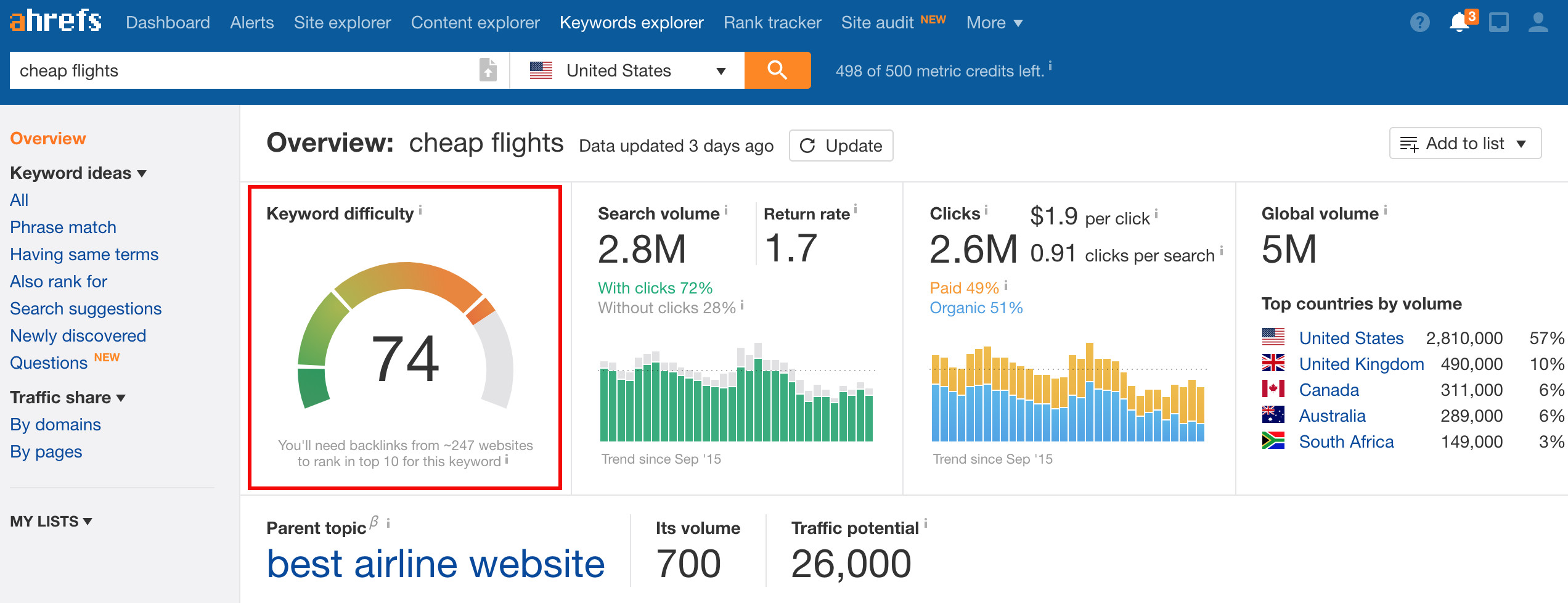
Keyword competition is not only a factor of the number of web pages competing for a keyword, but also of the quality, or what is usually called, the authority, of the competing websites.
High authority websites are more difficult to outcompete in the search rankings than lower authority websites.
Returning to our example at the beginning of this article, we saw that the keyword “Holidays to Thailand” had over 40 million competing webpages, but potentially the more important question, is how authoritative are the top 20-30 results.

As you can see, the competition for this keyword is pretty tough, with major websites like Virgin Holidays, Office Holidays, Travel Supermarket, Tomas Cook and TUI, all competing for the top organic spot.
We explain how authority is determined later in this article, but for now it’s important to note that:
High levels of competition – in terms of number of competing webpages and the authority of the top websites – determines how likely you are to rank for a keyword over time.
On-page SEO and Content
On-page SEO refers to techniques used to help search engines, like Google, establish what a website and its individual webpages are all about.
On-page SEO can be quite technical, but to achieve big wins and get ahead of your competition, there are really only two key areas to focus on:
- Relevancy
- User Experience
Let’s look at each.
Relevancy
For a search engine to understand what your website is all about, and then match it with relevant search keywords, you need to establish clear relevancy.
Website relevancy is achieved through effective 'labeling' of a webpage and through content.
In terms of labeling, there are five key areas on a webpage – URL, Page Title, Header Tags, Media Tags and Meta Data – that a search engine explores to understand what keywords would be relevant to a page.
- URL is the web address of a webpage, and like a physical mailing address, a web address with words explaining the address is much easier for a search engine to understand than one with random letters and numbers.
- Page Title, also called Header 1 or H1, is the title of the page and is usually displayed at the top of a webpage and in the search result.
- Header Tags are the sub-headers on a page and are often referred to as Header 2 (H2), Header 3 (H3), Header 4 (H4), and so on. Sub-headers are used to structure content, but are also useful in signaling relevancy to a search engine.
- Media Tags refer to the naming of images, graphics, videos and charts. In most cases, a search engine cannot understand what an image or chart is about unless it is tagged with a name. This is often called an Alt Tag.
- Meta Data is information that is stored on the page but is only visible to search engines. It usually sets out the Meta Title and Description for a page, which is the information displayed in a search result.
If you use a DIY web platform like Wordpress to run your website (see Web Design and Development), then there are some great plugins, like Yoast SEO and All-In-One-SEO, that help manage these on-page signals for you.
The best travel websites make sure that their webpages clearly target keywords using these five on-page signals.
For example, look at the search result for the keyword: “Best Hikes in Europe”.
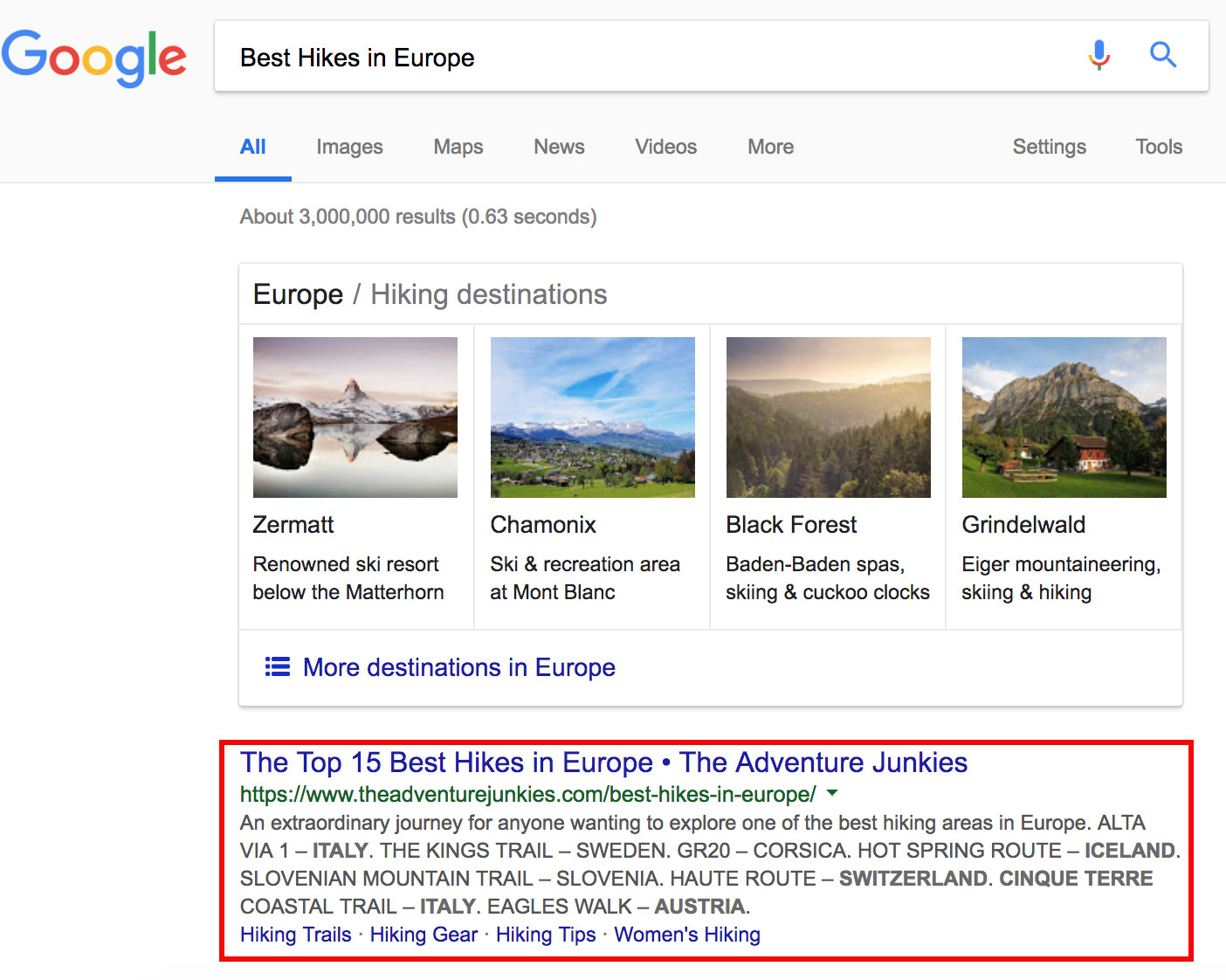
Notice how the URL, Title and Meta Data in the first result uses the keyword phrase.
Once you click the result (see below) and visit the page, notice the Page title with the keyword.
Moreover, if you were to save the image, you would see that the image title captures the keyword, and, as you scroll down, the sub-headers do the same.

QUICK EXERCISE
Let’s assume you have followed the keyword advice above and have found a good volume, high intent and low competition keyword to target.
Use the labeling guide above to create a webpage correctly:
- URL
- Page Title
- Header Tags
- Media Tags
- Meta Data
Remember to install and use a plugin like Yoast SEO if your website runs on Wordpress.
In addition to following the best practice for on-page labeling, the other key method to establish relevancy is via content.
We have a detailed article on Content Marketing; so will only touch on content briefly here.
Take a minute to think about which website appears in almost every search that you make.
If you are like most people, you probably thought of Wikipedia, and you would be right. The English Wikipedia has nearly 6 million articles and gets close to 250 million page views a day.
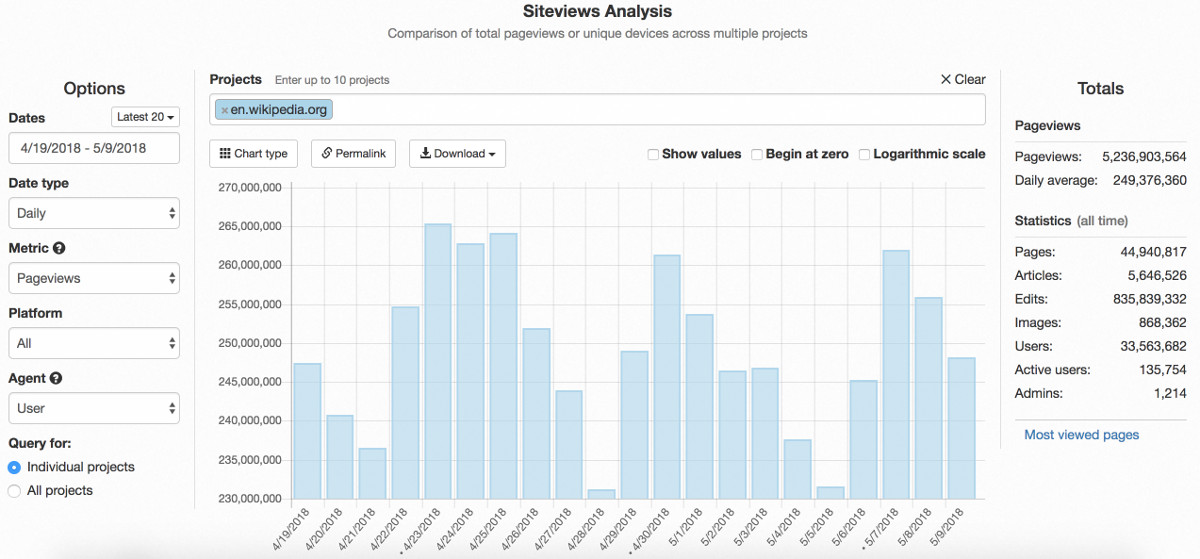
Why does Wikipedia get so much traffic?
Apart from being an incredible community, the reason for Wikipedia’s success is deep, relevant content that is regularly refreshed and thoroughly interlinked.
Content that goes into great depth to answer a user's search query is usually keyword rich, meaning the keyword (and its synonyms) the page is targeting appear throughout the content. This makes it easy for search engines like Google to establish relevancy.
The Internet is a dynamic space, which means things are forever changing. Content that is regularly refreshed helps search engines find the most up-to-date information.
As we will discuss in our Content Marketing article, even content that is evergreen needs to be updated occasionally.
Finally, content that is well interlinked or hyperlinked helps search engines index a website more effectively.
Imagine a page on your website that has no internal links from other pages on your website. It’s an island on its own. A page like this would be difficult for a search engine to find, and when it is found, the search engine may think it is unimportant as none of the other pages on the website link to it.
Great content signals relevancy to search engines by providing deep, insightful information, that is kept up-to-date and interlinked with other deep relevant content throughout a website.
QUICK EXERCISE
Take a few minutes to browse your website. Pay particular attention to your tour pages and your blog pages.
Do these pages clearly establish relevancy for targeted keywords?
Are there clear labeling signals on your pages or do they break the best practice principles for URLs, Page Titles, Header Tags, Media Tags and Meta Data?
Does your content go into great detail? Does it read well and is it well laid out with sub-headings? Has it recently been refreshed and is it well interlinked?
Create a priority plan to improve relevancy through updating the labeling signals and content on the most important pages.
Pro Tip: Do not change existing URLs unless advised by an SEO consultant. Changing a URL can mean losing search engine ranking as the authority and trust for a page is lost when the URL changes. If you have to change a URL make sure you redirect it to the new URL destination.
User Experience
The second area to focus on for on-page SEO is the user experience.
Search engines care a lot about the user experience.
Assuming a search result is perfectly mapped to a user’s search query, the next thing a search engine wants is for the user to have a great experience when they click a result and visit a page.
If a user were to click a result, visit a page and then immediately click back and return to the search, then the search engine would know the result it provided was either not relevant to the search query or the experience on the site they sent the user to was poor.
Search engines use three main methods to determine a user’s experience on a webpage.
Web analytics data
Assuming you have Google Analytics installed on your website you can track all sorts of user behavior.
Three key metrics that search engines use to understand a user’s experience are:
- Time on page
- Number of page views, and
- Bounce rate
Generally high time on page (2+ minutes), high page views (3+ page views per session) and a low bounce rate (i.e. the % of visitors that leave from the same page they arrived on) signal a good user experience.

For example, this website has relatively strong user metrics. Time on-page is around 2.5 minutes and bounce rate for an information website is not too bad. Page views could be a little higher.
QUICK EXERCISE
Login to your Google Analytics account and explore your web analytics. Start by looking at the overall performance of your site. What is your overall time on page, page views and bounce rate?
Now drive down into just organic traffic (from the dashboard click ‘Add Segment’ and select Organic Traffic). This will add another color chart to your analysis so that you can see how well your site is performing for organic traffic.
In the left-hand menu, click on Behavior > Site Content > All Pages. This will show you which pages on your site get the most traffic and how each page is performing. Show as many rows as possible and then export this data to CSV to analyze pages that are performing poorly.
Make a priority list of pages to update and improve so as to drive time on page and page views up, and bounce rate down.
Adding video content, improving design and written content and hyperlinking to relevant pages within your site can help improve performance metrics.
Page load speed time
Most users nowadays have a very short attention span. If a website takes more than a couple of seconds to load, a user will click back.
Search engines know this and track websites’ load speed.
Websites that take longer than a few seconds to load may be classified as providing a poor user experience.
There are a number of services you can use to test your page load speed. The three most popular are Google’s Page Speed Tool, Pingdom and GTMetrix.
For example, here is the page speed result for Tripadvisor’s homepage. As you can see it is performing relatively well.
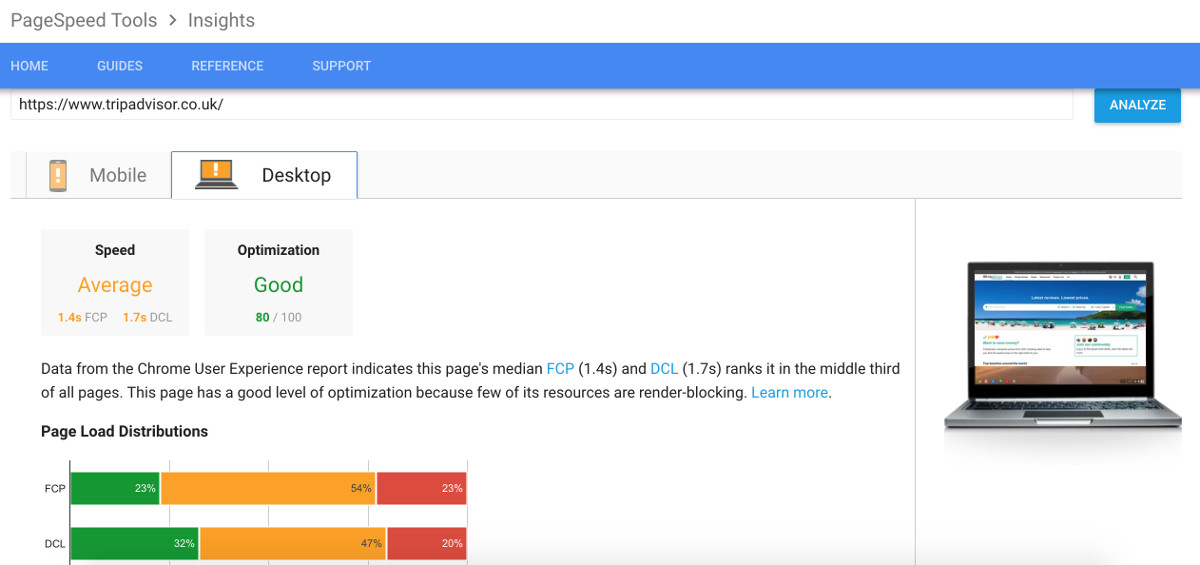
Suggested Reading
- Improving page speed can be quite technical. For guidance, we recommend you start by reading Google’s guide on Page Speed and potentially employing the services of a qualified web developer to help you speed up your site.
Mobile responsiveness
Over 50% of web traffic nowadays is from mobile devices. This means that if your website is not mobile-friendly you are undoubtedly providing a poor user experience.
For the last few years, search engines have rewarded sites that are mobile-friendly.
Going forward it is becoming increasingly difficult to rank in the search engines with a site that isn’t mobile-friendly.
To ensure that your site is responsive make sure to use Google’s mobile friendly test.
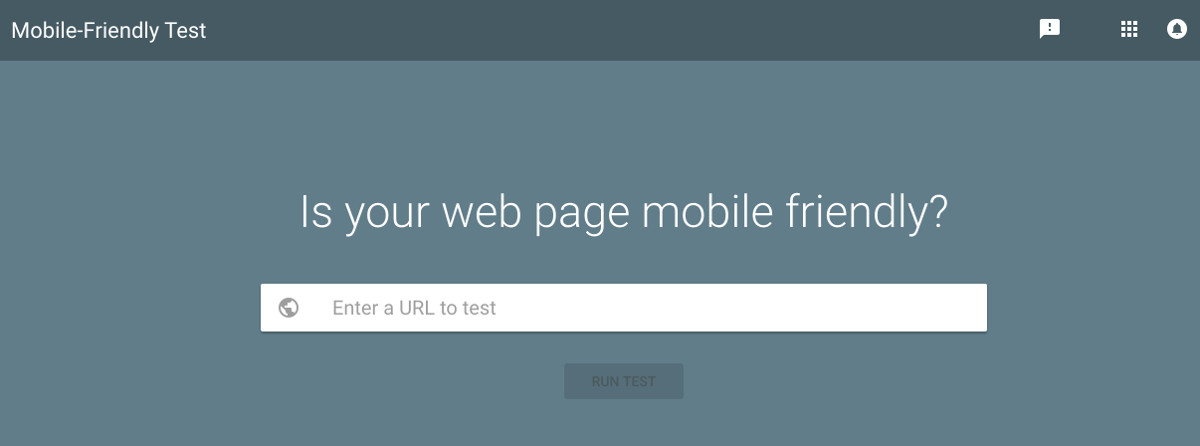
There are a number of other important on-page SEO ranking factors, like html validation and mark-up, site structure and schema, SSL certification, server errors and hosting configuration, however, for the purposes of this article, the importance of relevancy through on-page labeling and content, and user experience, are 80% of the battle.
Suggested Reading
- Check out Moz’s Beginner Guide to Search Engine Optimization.
Off-page SEO
Off-page SEO refers to techniques used to established trust and authority signals to a website.
Among the many signals that search engines use to determine organic rankings, two are particularly important in terms of off-page SEO:
- Backlinks
- Social signals
Let’s look at each briefly.
Backlinks
A backlink is a link that points from one website to another.
Search engines use the number of backlinks pointing to a webpage and their quality as a vote of confidence or popularity measure.
For example, a major travel website like Kuoni Travel has over 110,000 backlinks from over 3,200 domains. Many domains might link multiple times to a website.
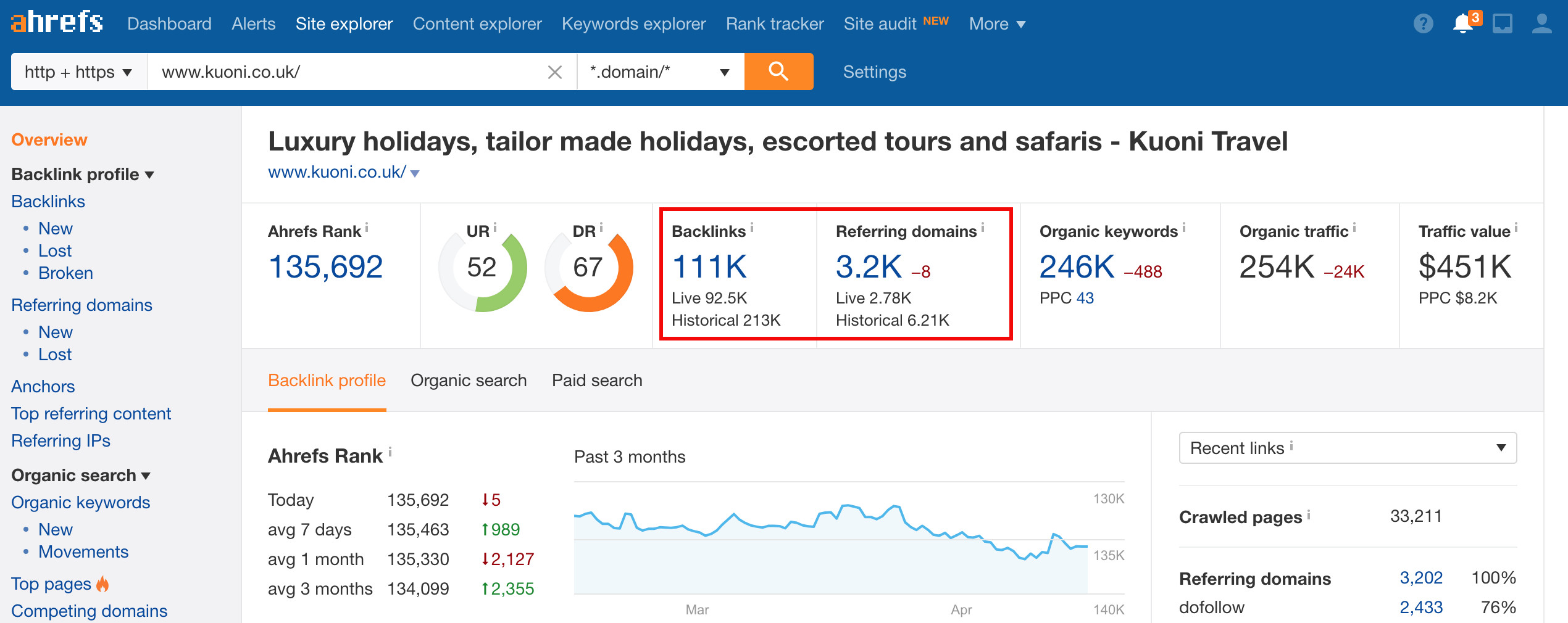
The more backlinks a webpage gets from authoritative and relevant sources, the higher that page will rank in the search engines.
For example, returning to Kuoni, we can see that they have 100s of very high quality links from sites like Youtube, Wikipedia, Vimeo, Tripadvisor, Medium, The Guardian and Forbes, to mention a few.
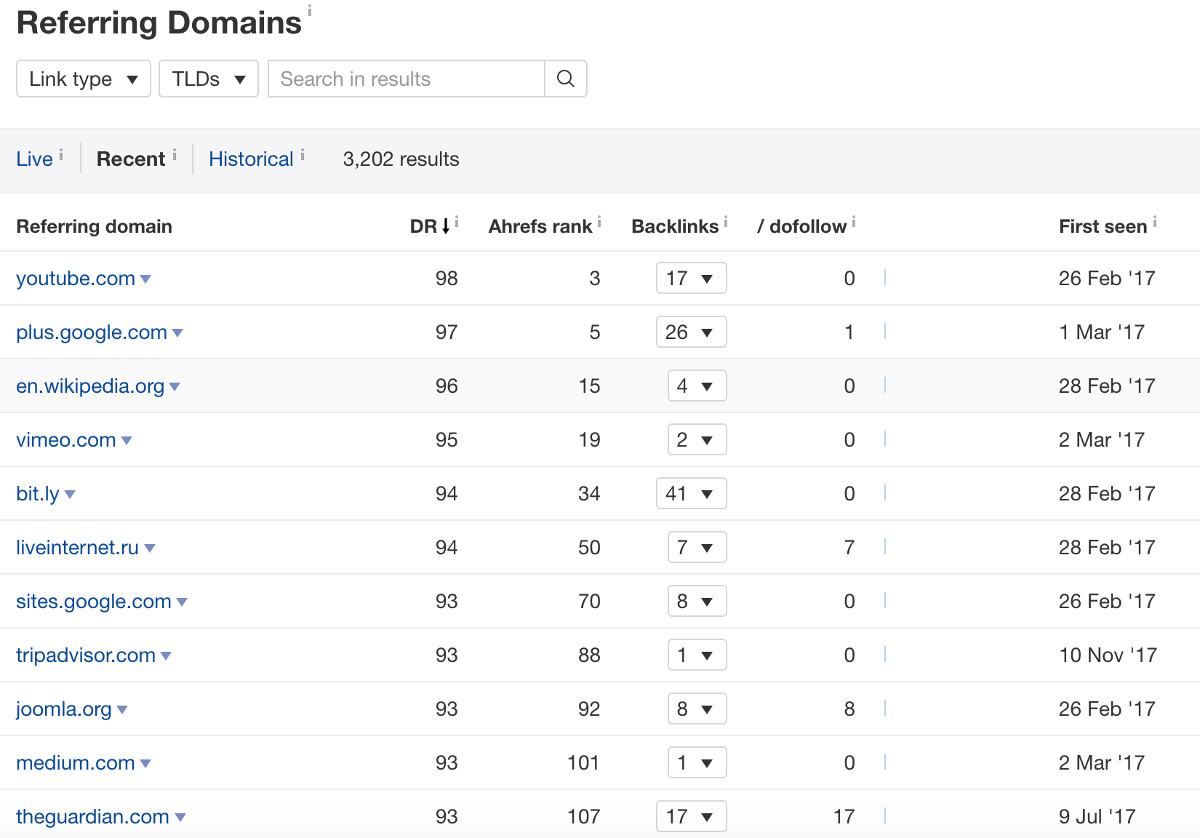
The best type of backlink is one that comes from a highly authoritative website that is also highly relevant to your page.
For example, imagine you have a webpage targeting the keyword, “Best Yoga Retreats”. You have followed all the best practice on-page SEO tips above and therefore have a highly relevant page with great content and an awesome user experience.
Because your page is so great you start to get some organic search traffic and before you know it other websites start linking to you.
Initially you get some links from small travel blogs, but then, one day, you get a link from a major publication, for example, Lonely Planet. And not only that, but the Lonely Planet page is all about yoga retreats.
Congratulations! You have just scored a highly authoritative link that is also highly relevant to your webpage. This is SEO gold and will help your page rank much higher in the search engines.
Of course scoring quality backlinks like this one is incredibly difficult, but not impossible.
The trick is to produce great content and then promote that content via blogger outreach, guest posting, social media and PR. The more you can shout about your content the more likely it will be read, shared and linked to.
There are many techniques that can be used to get backlinks to one’s website. For further reading, see below resources.
Suggested Reading
- For great ideas on how to get backlinks we recommend following and reading Brian Dean’s website, Backlinko.
Social signals
With the popularity of social media platforms like Facebook, Twitter, Instagram and Pinterest, social signals have also become an important off-page ranking factor for SEO. Although, not as important as backlinks.
The way social signals work is quite similar to backlinks insofar that the more social shares and likes a webpage gets, the more likely a search engine is to pick up the signal that this page is popular.
The quickest and easiest way to generate social activity is to get active on social media platforms.
If you haven’t already setup social media pages for your travel brand, we recommend you do that now. The type of social media page(s) you decide to setup will depend heavily on where you think your audience is most active. At a minimum though, you should have a Facebook page.
There is far too much to cover in this article in terms of growing a social media presence, so we highly recommend you take the time to check out our suggested reading below.
Once you have a clear social media strategy make sure you invest the time to develop your social media following and actively share your tours and content.
Suggested Reading
- For great ideas on how to grow your social media presence check out SproutSocial.
Summary
Generating organic traffic to your website requires a good knowledge of SEO.
As a small travel operator you can outsource SEO to a consultant or agency, but this can be costly, ineffective and in the worse case hurt your website.
This is why it is worthwhile learning the basics and doing as much as possible in-house.
There are many free and affordable tools online that can help you accelerate the process, and the web is awash with great resources on how to rank organically. Throughout this article we have linked to many of these resources and we encourage you to explore them in detail.
SEO starts with keyword research, as you need to know what you are optimizing for before you start.
Search engines use complex algorithms that consist of 100s of signals to rank webpages for keywords. Broadly speaking, these signals fit into two buckets – on-page and off-page SEO.
Mastering them is the key to ranking online and generating loads of organic traffic.
However, even the best SEO takes a long time to work. In the short term, there are a few other ways to drive traffic. In the next article, we look at one of the most effective methods – PPC Google Advertising.
Did you enjoy this article? Get a FREE e-book: 150-page guide that covers everything from establishing a winning travel brand to delivering a market-leading service.
New resources, straight to your inbox
We’re committed to your privacy. WeTravel uses the information you provide to us to contact you about our relevant content, products, and services. You may unsubscribe at any time.

